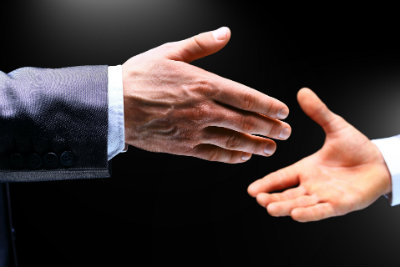Body language tends to focus on postures and gestures. Postures are still configurations of body parts. A military bearing involves a stiff uprightness. A bored adolescent will slouch. When sitting, the alpha male assumes the “power spread,” with legs apart and elbows out to the side. Thus postures are said to convey a person’s attitude.
 Gestures are isolated actions of individual body parts. Some gestures are iconic, such as pointing the finger to indicate direction or shaking the head to indicate “no.” Other isolated gestures carry specific cultural meanings. For example, the explorer Captain Cooke is said to have been killed by the Hawaiians when he attempted to shake hands, for this gesture of friendship in England carried an entirely different meaning in Hawaii.
Gestures are isolated actions of individual body parts. Some gestures are iconic, such as pointing the finger to indicate direction or shaking the head to indicate “no.” Other isolated gestures carry specific cultural meanings. For example, the explorer Captain Cooke is said to have been killed by the Hawaiians when he attempted to shake hands, for this gesture of friendship in England carried an entirely different meaning in Hawaii.
Scholarly study and popular body language books concur – postures and gestures have meaning. Unfortunately, this is where most analysis of physical behavior stops. Beyond the posture and the gesture there is nothing.
I find this quite curious, because idiomatic expressions in English indicate that postures and gestures can be misleading. “To posture” is to assume a false or affected attitude – to pose as something one is not. To “make a gesture” suggests that the action was done as a formality – not necessarily as a sincere expression.
If postures and gestures are the sum of what can be deciphered from the ephemeral stream of human movement, then much body language is misleading – a dumb show put on to fool the observer. This was the cynical conclusion of sociologist Erving Goffmann, as he brilliantly argued in The Presentation of Self in Everyday Life.
I am not so cynical, however. I believe it is possible to see beyond pretense, to discern genuine expressions in human movement.
This was Warren Lamb‘s quest. It took him beyond posture and gesture. In the following blogs, I will discuss Lamb’s discoveries in more depth.
